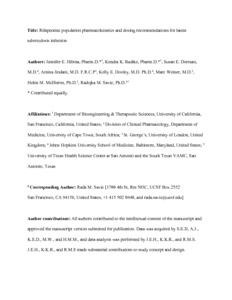Hibma, JE; Radtke, KK; Dorman, SE; Jindani, A; Dooley, KE; Weiner, M; McIlleron, HM; Savic, RM
(2020)
Rifapentine Population Pharmacokinetics and Dosing Recommendations for Latent Tuberculosis Infection.
Am J Respir Crit Care Med, 202 (6).
pp. 866-877.
ISSN 1535-4970
https://doi.org/10.1164/rccm.201912-2489OC
SGUL Authors: Jindani, Amina
![[img]](https://openaccess.sgul.ac.uk/111954/2.hassmallThumbnailVersion/Rpt_AJRCCM_Manuscript_Rev_20200514_CLEAN_FINAL.pdf)  Preview |
|
PDF
Accepted Version
Available under License ["licenses_description_publisher" not defined].
Download (2MB)
| Preview
|
Abstract
RATIONALE: Rifapentine has been investigated at various doses, frequencies, and dosing algorithms but clarity on the optimal dosing approach is lacking. OBJECTIVES: In this individual participant data meta-analysis of rifapentine pharmacokinetics, we characterize rifapentine population pharmacokinetics, including autoinduction, and determine optimal dosing strategies for short-course rifapentine-based regimens for latent tuberculosis infection. METHODS: Rifapentine pharmacokinetic studies were identified though a systematic review of literature. Individual plasma concentrations were pooled, and non-linear mixed effects modeling was performed. A subset of data was reserved for external validation. Simulations were performed under various dosing conditions including current weight-based methods and alternative methods driven by identified covariates. MEASUREMENTS AND MAIN RESULTS: We identified 9 clinical studies with a total of 863 participants with pharmacokinetic data (n=4301 plasma samples). Rifapentine population pharmacokinetics were described successfully with a one-compartment distribution model. Autoinduction of clearance was driven by rifapentine plasma concentration. The maximum effect was a 72% increase in clearance and was reached after 21 days. Drug bioavailability decreased by 27% with HIV infection, decreased by 28% with fasting, and increased by 49% with a high-fat meal. Body weight was not a clinically relevant predictor of clearance. Pharmacokinetic simulations showed that current weight-based dosing leads to lower exposures in low weight individuals, which can be overcome with flat dosing. In HIV-positive patients, 30% higher doses are required to match drug exposure in HIV-negative patients. CONCLUSIONS: Weight-based dosing of rifapentine should be removed from clinical guidelines and higher doses for HIV-positive patients should be considered to provide equivalent efficacy.
| Item Type: |
Article
|
| Additional Information: |
Originally Published in: Jennifer E Hibma , Kendra K Radtke , Susan E Dorman , Amina Jindani , Kelly E Dooley , Marc Weiner , Helen M. McIlleron , and Radojka M. Savic . Rifapentine Population Pharmacokinetics and Dosing Recommendations for Latent Tuberculosis Infection. American Journal of Respiratory and Critical Care Medicine. 2020;202:866-877.
DOI: 10.1164/rccm.201912-2489OC
Copyright © 2020 by the American Thoracic Society
The final publication is available at https://doi.org/10.1164/rccm.201912-2489OC. |
| Keywords: |
latent tuberculosis, population pharmacokinetics, rifamycins, rifapentine, tuberculosis, 11 Medical and Health Sciences, Respiratory System |
| SGUL Research Institute / Research Centre: |
Academic Structure > Infection and Immunity Research Institute (INII) |
| Journal or Publication Title: |
Am J Respir Crit Care Med |
| ISSN: |
1535-4970 |
| Language: |
eng |
| Dates: |
| Date | Event |
|---|
| 15 September 2020 | Published | | 15 May 2020 | Published Online | | 14 May 2020 | Accepted |
|
| Publisher License: |
Publisher's own licence |
| PubMed ID: |
32412342 |
 |
Go to PubMed abstract |
| URI: |
https://openaccess.sgul.ac.uk/id/eprint/111954 |
| Publisher's version: |
https://doi.org/10.1164/rccm.201912-2489OC |
Statistics
Item downloaded times since 11 Jun 2020.
Actions (login required)
 |
Edit Item |



